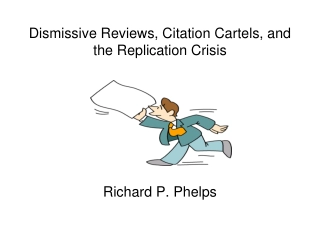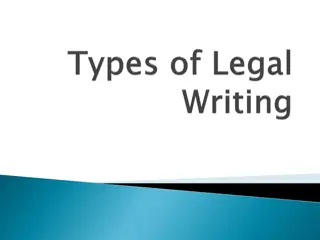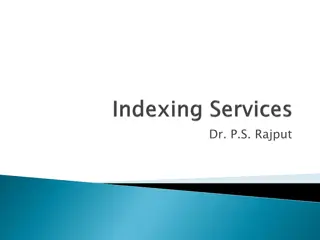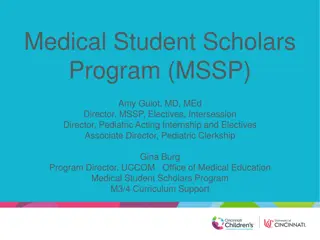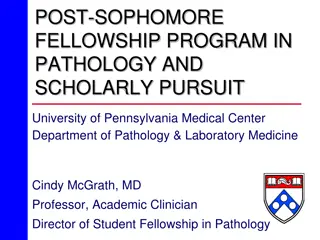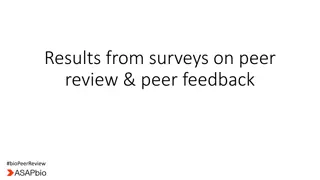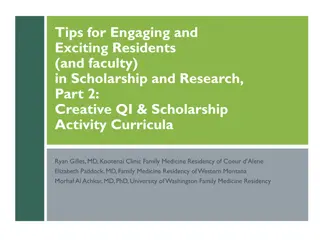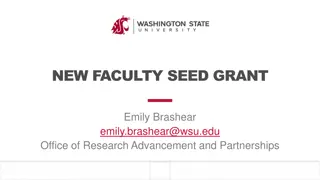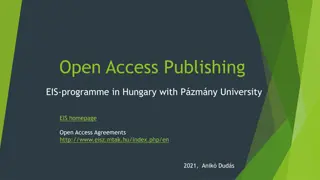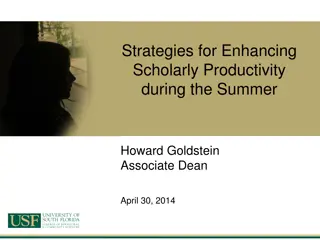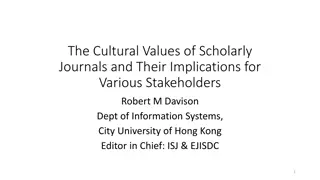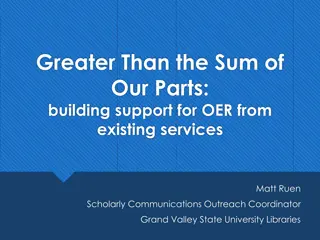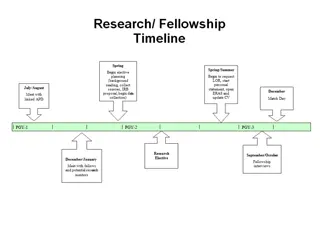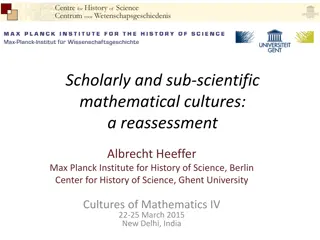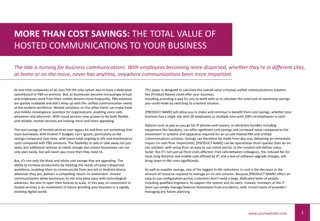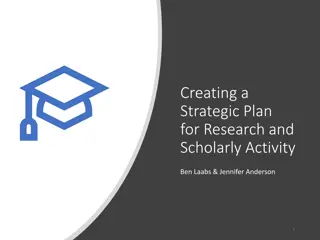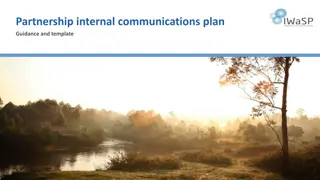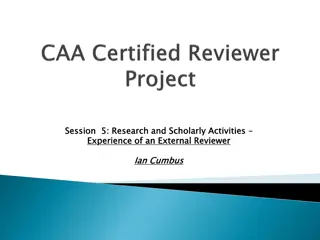Scholarly Communications among NMLIS Professionals: An Analysis
Conducting a content analysis of scholarly communications over the NMLIS online forum in 2016 to explore the extent, categories, and contributors of discussions and file attachments among LIS professionals.
Download Presentation

Please find below an Image/Link to download the presentation.
The content on the website is provided AS IS for your information and personal use only. It may not be sold, licensed, or shared on other websites without obtaining consent from the author.If you encounter any issues during the download, it is possible that the publisher has removed the file from their server.
You are allowed to download the files provided on this website for personal or commercial use, subject to the condition that they are used lawfully. All files are the property of their respective owners.
The content on the website is provided AS IS for your information and personal use only. It may not be sold, licensed, or shared on other websites without obtaining consent from the author.
E N D
Presentation Transcript
Library Professionals Scholarly Communications over Online Forum: Content Analysis of New Millennium LIS Professionals (NMLIS) Dr. Akhandanand Shukla Assistant Professor Department of Library & Information Science Mizoram University, Aizawl Jacob MS Dawngliana Research Scholar Department of Library & Information Science Mizoram University, Aizawl
INTRODUCTION LIS knowledge transfer. Professional - scientific dissemination and Seminars & Training Programs lesser opportunities for communication between LIS Professionals. Traditional methods of communication not interactive and time consuming. Internet and Mobile technology revolutionary communication methods.
Internet - platform to expand the scope of collaboration and professional conversations. Online forum - potential to gain knowledge from and share experiences with other library professionals. Library professionals different geographical locations participation online social medium professional communication wider audience. Online discussion forum - Web-based communication tools communicates asynchronously.
New Millennium LIS Professionals (NMLIS) Group - widely accepted and used by the library professionals. NMLIS created on 22nd October 1999 by Prof. N. Laxman Rao on Yahoo! The biggest discussion group in LIS 3111 Group members & 33269 posted communications (as on 16.03.2017). Content analysis is described as the scientific study of content of communication (Prasad, 2008).
SCOPE 2403 scholarly communications (messages). For the year 2016. From 1st January, 2016 to 31st December, 2016.
OBJECTIVES Examine the extent of scholarly communications among LIS professionals over online forum. Examine the category of scholarly communications among LIS professionals over online forum. Determine the focus of scholarly communications over online forum. Find out the most prolific contributors of scholarly communications over online forum.
Examine the extent of file attachments and category of file types communicated over online forum. Find out the degree of contribution and most prolific contributor for job posts communications over online forum. Find out the degree of contribution and most prolific contributor for library specific scholarly communications over online forum.
METHODS & PROCEDURES Survey and Observation methods of research used. Tracked the data about level of involvement, type of activity, and number of scholarly communications (postings) with description. Archived conversations tracked for the period of one year from 1st January, 2016 to 31st December, 2016. Conversations collected and grouped into different categories and transcribed group messages were coded appropriately.
DATA ANALYSIS & INTERPRETATION Extent of Scholarly Communications Total 2403 scholarly communications. Highest no. of communications - January (235, 9.78%) followed by June & September (232, 9.65% each). Least no. of communications - October (148, 6.16%). In communications. a year, 7 months have more than 200 Monthly average of communications is 200 per month.
Category of Scholarly Communications Eight (8) kinds of categories have been identified: Conference Communications (CON) Faculty Development Communications (FDM) Job Posts Communications (JOB) General Information Communications (GIC) Library Science Communications (LSC) Greetings Communications (GRC) Obituary Communications (OBI) Other Communications (OTH)
Focus of Scholarly Communications General Information Communications (GIC) 34.42% Library Science Communications (LSC) 23.3% Conference Communications (CON) 18.73% Other Communications (OTH) 10.32% Job Posts Communications (JOB) 9.74% Greetings Communications (GRC) 1.62% Faculty Development Communications (FDM) 1.21% Obituary Communications (OBI) 0.67%
Focus of Scholarly Communications Categories CON, FDM, JOB, and LSC are directly related to development of LIS professionals. 52.97% scholarly communications belongs to four core categories (CON, FDM, JOB, and LSC) identified for professional development. Except General Information Communications (GIC) which is sharing one-third communications, Conference Communications (CON), Job Posts Communications (JOB), and Library Science Communications (LSC) were the major focus of scholarly communications in NMLIS group. (34.42%) scholarly
Most Prolific Contributors Months Extent of Contributors Top 5 Contributors in Coden Name (with extent of Scholarly Communications) January 41 AMR (55) NL (46) PJ (42) NLR (40) DK; ASLA (4) February 31 PJ (79) NLR (47) NL (45) AMR (20) GS (5) March 25 PJ (53) NL (45) AMR (23) NLR (15) RCG (4) April 34 PJ (63) NL (48) NLR (40) AMR (19) AL (6) May 30 NLR (62) NL (53) PJ (27) LR (11) AL (8) June 29 PJ (101) NLR (52) NL (36) TLA (9) ASLA (5) July 34 NL (67) PJ (66) NLR (45) PER (6) GS (5) August 30 PJ (49) NL (42) NLR (35) ASLA; AL (4) TLA (3) September 31 PJ (86) NLR (54) NL (44) AMR (9) PER (4) October 23 PJ (52) NLR (21) AMR (24) NL (16) AL (11) November 25 PJ (74) NL (27) NLR (25) AMR (5) DS (3) December 24 PJ (97) NL (37) NLR (20) AMR (18) AL (7) Legends: AMR = A Madhava Rao; PJ = Pralhad Jadhav; NL = Naglaxman; NLR = Prof. N. Laxman Rao; LR = Laxman Rao; GS = gopalakrishnan shanmugam; TLA = Telangana library Association; ASLA = ASIAN LIBRARY ASSOCIATION; DK = Dattatraya Kalabande; PER = Prakasan E.R.; RCG = Dr. Ramesh C Gaur; AL = **@nil**; DS = dinesh sanadi.
Most Prolific Contributors Name of Contributor(s) Extent of Contribution (Posts) 13 36 173 4 3 10 11 506 456 10 789 4 12 Percentage (out of 2403) Frequency of Contribution (Months) 3 5 8 1 1 2 1 12 12 2 12 1 2 ASLA AL AMR DK DS GS LR NL NLR PER PJ RCG TLA 0.54% 1.49% 7.19% 0.16% 0.12% 0.41% 0.45% 21.05% 18.97% 0.41% 32.83% 0.16% 0.49%
Extent of File Attachments Months Extent of Scholarly Communications 235 230 163 214 192 232 227 165 232 148 159 206 2403 Extent of Communications having File Attachments 45 35 11 37 30 33 35 36 40 25 23 37 387 Extent of Files 65 68 20 79 44 43 54 58 44 51 26 47 599 January February March April May June July August September October November December Total
Extent & Category of File Types 10 file types identified for scholarly communication. Microsoft Power Point (PPT), audio files and video files have not been observed as file attachments. Majority of file attachments found in the form of Image files (50.41%) followed by PDF (29.04%), and MS-Word (9.01%). MS-Excel, HTML and Zip files appeared rarely. 10.68% files are unidentified and kept under Others category. Most used file types Image files, PDF files and MS- Word files which consists 88.48% of total files as attachments.
Degree of JOB Posts Contribution & Contributor Months Extent of Scholarly Communications 235 230 163 214 192 232 227 165 232 148 159 206 2403 Extent of JOB Posts 44 27 19 22 22 20 17 18 29 2 6 8 234 Top Contributor January February March April May June July August September October November December Total AMR (34) NL (11) NL (13) NL (6) NL (9) NL (9) NL (8) NL (6) NL (15) NL (1), NLR (1) NL (3) NL (3), NLR (3) NL (84), AMR (34)
Degree of LSC Posts Contribution & Contributor Months Extent of Scholarly Communications 235 230 163 214 192 232 227 165 232 148 159 206 2403 Extent of LSC Posts 60 46 74 48 38 27 49 30 46 45 38 59 560 Top Contributor January February March April May June July August September October November December Total AMR (18) AMR (15) PJ (25) AMR (17) NL (12) PJ (11) NL (14) PJ (13) PJ (19) AMR (24) PJ (16) PJ (22) PJ (107), AMR (74), NL (26)
FINDINGS OF STUDY In one year duration, NMLIS group has 2403 scholarly communications. On an communications takes place per month. Scholarly communications have been grouped into 8 identified categories. These categories are: Conference Communications (CON), Communications (FDM), Job Posts Communications (JOB), General Information Communications (GIC), Library Science Communications (LSC), Greetings Communications (GRC), Obituary Communications (OBI), and Other Communications (OTH). General Information Communications (GIC) category is highly focused in the group posts followed by Library Science Communications (LSC), Conference Communications (CON), Other Communications Communications (JOB). average 200 scholarly Faculty Development (OTH) and Job Posts
Pralhad Jadhav is the most prolific contributor. As per frequency of contribution, Naglaxman, Prof. N. Laxman Rao and Pralhad Jadhav contributed every month in a year. Pralhad Jadhav has contributed 789 (32.83%) scholarly communications alone. There are 387 scholarly communications having file attachments Total 599 files were found attached in 387 scholarly communications. There are 10 file types identified for categorization of 599 files found as attachment. Image and PDF files found as most communicated file types.
234 Job posts were communicated in the group during the study period which is 9.74% of total scholarly communications. Naglaxman is the highest contributor of Job posts communications and contributed 35.89% of total Job posts. 560 communicated in the group during the study period which is 23.3% of total scholarly communications. Library Science Communications were Pralhad Jadhav is the highest contributor of LSC posts in terms of frequency and in terms of number of posts also.
CONCLUSION Since start of the LIS profession, it was the primary work of library professionals to disseminate and share knowledge and information among users group. The advent of Internet and World Wide Web has increased the work beyond the boundary of library. For the development of LIS profession and self development, library professionals have their own circle for discussion. Nowadays, many Web based platforms are available through which they are making larger group of professionals and sharing scholarly communications amongst them. The library specific discussion group contains all kinds of latest information of LIS profession from all over the world. Such kind of specific groups should be run by LIS professionals to boost up their caliber by enhancing the field specific knowledge and technical know-how of the field.


